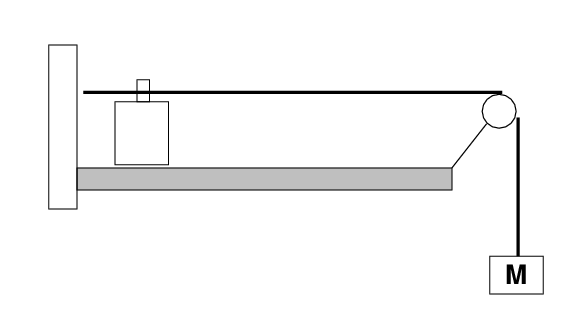Standing waves on a string experiment (part 2)

Your goal today is to
- predict the frequencies for the first four standing
waves on a piece of stretchy cord
- measure the actual frequencies and compare them
to your predictions
In order to predict those frequencies, you'll need to
- set up the equipment as shown above,
using a hanging mass of M = 650 grams
- measure the length L between pulley and oscillator carefully
- determine the linear mass density μs
of the cord when it is stretched by the hanging mass

- compute the velocity of waves travelling on this cord

- using the length L,
and the velocity of waves on the cord,
predict the four lowest frequencies (and uncertainties in each)
which
will set up a standing wave on the cord
- draw a picture of each of these four waves
Stop and show your work to an instructor. When he approves, continue.
Now, time to find out if you were right!
Measure the actual frequencies.
- Adjust the oscillator to find the frequency which yields
the fundamental mode standing wave. Record this value,
and the uncertainty. Explain how you estimated the uncertainty.
- Repeat for the next three frequencies. Record all values neatly in
a table.
- Compare your results to your predictions.
Are the predictions equal to the results,
within the uncertainties?
Discuss briefly.
If you have time ...
- Predict the frequency which should yield 10 antinodes.
Write down your value.
Then look for this frequency empirically.
Does the actual frequency agree with the
prediction within their uncertainties?
- Modify the mass of the hanging weight to M = 550 g.
Compute at least three frequencies which should yield
standing waves. Write them down.
Then look for the standing waves empirically.
the actual frequencies agree with the predictions within
their uncertainties?



